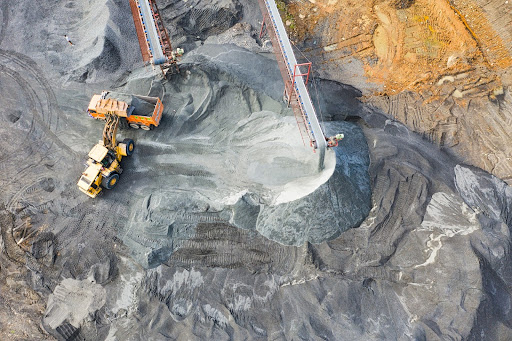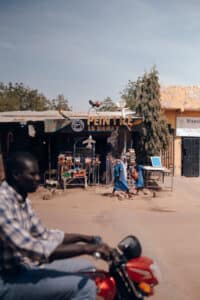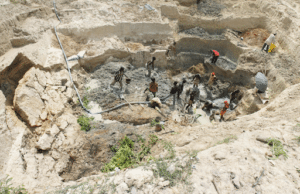High-quality quantities of gold, copper, ilmenite, and tantalum are produced in Kenya by mining. Non-metallic minerals like soda ash, limestone, salt, niobium, fluorspar, and fossil fuels are also abundant in the mining industry in Kenya.
Less than 1% of Kenya’s GDP is made up by the mining sector, although that percentage might rise to 4% to 10%. This shows that Kenya has a lot of natural resources that haven’t been used yet and that there may be a lot of room for growth.
On June 24, 2022, a Memorandum of Understanding (MoU) was signed between the Kenya Chamber of Mines (KCM) and the Kenya National Chamber of Commerce and Industry (KNCCI). The KCM looks out for the interests of Kenyan miners, mining experts, exploration firms, traders, and suppliers.
The relationship is crucial for addressing economic and policy issues in Kenya’s mining and extractive sectors, according to Chamber President Richard Ngatia, who spoke during the ceremony where the MoU was signed.
The MOU will benefit local businesses since it recognizes that the Democratic Republic of the Congo (DRC) is one of the continent’s most mineral-rich nations. Large amounts of lithium, cobalt, tantalum, copper, cobalt, gold, diamonds, and copper can be found in the country. Kenya is rich in many jewels and gemstones, and according to Bernardine, it can become a global hub for the jewel industry.
Kenyan Economy
Kenya has been trying to grow its economy in a way that will bring in foreign direct investment since it became independent.
The latest plans for national development say that Kenya will still be the center of trade and finance in East Africa.
Because it possesses a seaport that can accommodate post-Panamax ships, a sizable manufacturing sector, excellent resources for agriculture and tourism, a highly qualified and industrial workforce, and a hub for regional international air travel, Kenya is in a good position in the region.
The three largest cities in Kenya Nairobi, Mombasa, and Kisumu are where most of the country’s industrial activity takes place. But it is expected that the transfer of power will give the county’s business hubs a new lease on life.
The Kenyan government is also dedicated to developing a better labor force that would benefit Kenyan companies. A strong pool of technical and vocational professionals has to be developed, and it is anticipated that most of these professionals will be young people from around the nation.
Nearly 60% of the population is under 25, and they contribute significantly to the nation’s economic base. The government intends to provide young people with the chance to work in important sectors like mining as well as launch and expand their own enterprises.
Mining Industry In Kenya – Potential And Future
Mineral exploration is still in its early stages in Kenya. The nation was initially designated as an agricultural region on a map.
For the following several generations, people ceased searching for minerals.
The mining industry is currently mostly focused on producing non-metallic items, and the country’s mineral resources have not been explored to their full potential. Kenya is the third-largest producer of soda ash and fluorspar worldwide.
Metals such as titanium, gold, and iron ore are currently produced in the nation. Kenya’s export figures demonstrate how rapidly this industry is expanding. In 2014, Kenya exported 281 metric tons of ilmenite, 52 metric tons of rutile, and 23 metric tons of zircon. However, it is anticipated that as the nation grows, it will significantly increase the annual world supply.
Then, with more exploration and use of mineral rights, it is expected that Kenya will be able to become a mining powerhouse for Eastern Africa.
Kenya recently said that the area along its coast has some of the world’s richest rare-earth mineral reserves.
Kenya will rank among the top five nations in the world for having the greatest rare earth resources thanks to the recent discoveries, which are estimated to be worth USD 62.4 billion.
Six of the top ten niobium deposits in the world are located in this nation. In the northeast of the country, commercial coal reserves have been found, and they are being looked into for possible production and use.
Kenya Mining In The African Context
Many international mining corporations have operations in Kenya. Tata Chemicals Magadi, which operates in the Lake Magadi region of the Great Rift Valley, is significant since it is one of Kenya’s top exporters and Africa’s largest producer of soda ash. Every year, it produces roughly 360,000 metric tons of soda ash.
Since 1971, Kenya Fluorspar Company Limited has been extracting fluorspar for export from the Rift Valley System. the third largest
Kenya earns money from the mineral fluorspar, which the company produces at an estimated 100,000 tons per year.
Since 1942, the company Africa Diatomite Industries Limited (ADIL) has been exporting diatomite from Gilgil, a town northwest of Nairobi. An estimated 6 million tons of high-quality diatomite resources are available to ADIL. Currently, ADIL is the only business in Kenya with deposits of high-quality diatomite.
Mineral Deposits In Kenya
Dolomite, marble, and limestone are abundant in Kenya and are mostly used in the construction and cement industries. East Africa Portland Cement Company (EAPCC), which has a capacity of 1.4 million tons per year, Bamburi Cement (Lafarge Group), which has a capacity of 2.3 million tons per year, and Athi River Mining, which has a capacity of more than 1 million tons per year, are three major cement producers in Kenya. Mombasa Cement and Savannah Cement may be able to make close to 1.5 million tons of cement each year.
According to Base Resources, this project is an advanced development project of the highest caliber. The Kwale mine is estimated to have 140 million tons of titanium. When the project is completed, Base Titanium, a subsidiary in Kenya, will produce 80,000 tons of rutile annually, or 14% of the global supply. Additionally, it will produce 40,000 tons of zircon and 330,000 tons of ilmenite.
In October 2012, Acacia Mining, formerly known as African Barrick Gold, acquired Aviva Corporation’s interest in the Bumbo base metal potential in Western Kenya. This was done through a joint venture with AfriOre International, a subsidiary of Lonmin Plc that is fully owned by Lonmin Plc.
The Ndori Greenstone Belt in Kenya, which has previously been examined and proven to have significant potential for gold, copper, lead, and zinc, is included in the project on a 2,800 km2 scale. The primary areas where gold systems and deposits of other metals may be found are the three main locations that Acacia Mining will concentrate on learning more about.
Working together in two locations where coal resources have been discovered are Fenxi Mining and Great Lakes Corporation, a local joint venture partner. The company estimates that there are more than 400 million tons of coal deposits in the region, with a market value of roughly 40 billion dollars. It expects to invest close to $500 million in exploration and production.
People Also Ask
Conclusion
Numerous locations throughout the nation have had minerals discovered and mapped. To determine the size of the majority of these mineral deposits, however, no thorough investigation has been carried out. However, it has been discovered that Kenya has a lot of ores and industrial minerals in enormous amounts.
Minerals include substances like fluorspar, titanium, niobium, and rare earth elements. Minerals also include gold, coal, iron ore, limestone, manganese, diatomite, diamonds, gypsum, and unrefined carbon dioxide.
The “reviving mining” project demonstrates the commitment of the Kenyan government to expanding the mining sector during the following 20 years.



